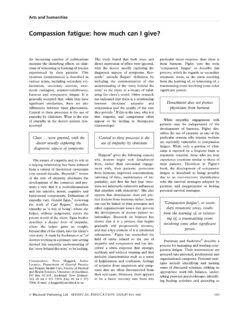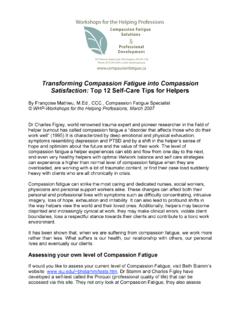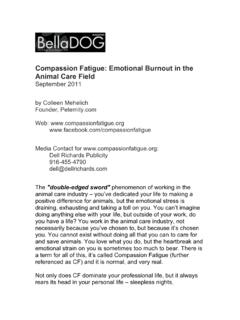Transcription of Running on Empty - Compassion Fatigue Awareness Project
1 Running on Empty : Compassion Fatigue in Health Professionals By Fran oise Mathieu, , CCC. Compassion Fatigue Specialist (Published in Rehab & Community Care Medicine, Spring 2007) The expectation that we can be immersed in suffering and loss daily and not be touched by it is as unrealistic as expecting to be able to walk through water without getting wet (Remen, 1996) What is Compassion Fatigue ? Our primary task as helping professionals is first and foremost to meet the physical and/or emotional needs of our clients and patients. This can be an immensely rewarding experience, and the daily contact with patients is what keeps many of us working in this field.
2 It is a Calling, a highly specialized type of work that is unlike any other profession. However, this highly specialised rewarding profession can also look like this: Increasingly stressful work environments, heavy case loads and dwindling resources, cynicism and negativity from co-workers, low job satisfaction and, for some, the risk of being physically assaulted by patients. Compassion Fatigue has been described as the cost of caring" for others in emotional and physical pain. (Figley, 1982) It is characterized by deep physical and emotional exhaustion and a pronounced change in the helper s ability to feel empathy for their patients, their loved ones and their co-workers.
3 It is marked by increased cynicism at work, a loss of enjoyment of our career, and eventually can transform into depression, secondary traumatic stress and stress-related illnesses. The most insidious aspect of Compassion Fatigue is that it attacks the very core of what brought us into this work: our empathy and Compassion for others. Who does it affect? Compassion Fatigue is an occupational hazard, which means that almost everyone who cares about their patients/clients will eventually develop a certain amount of it, to varying degrees of severity.
4 Statistics Canada recently published their first ever National Survey of the Work and Health of Nurses (2005) which found that close to one-fifth of nurses reported that their mental health had made their workload difficult to handle during the previous month. In the year before the survey, over 50% of nurses had taken time off work because of a physical Running on Empty illness, and 10% had been away for mental health reasons. Eight out of ten nurses accessed their EAP (employee assistance program) which is over twice as high as EAP use by the total employed population.
5 In addition, nurses reported on the job violence and were found more likely to experience on the job violence than all other professions. (ONA, 2006) A study of Cancer Care Workers in Ontario carried out in 2000 also found high levels of burnout and stress among oncology workers and discovered that a significant number of them were considering leaving the field: 50% of physicians and 1/3 of other cancer care professionals had high levels of emotional exhaustion and low levels of personal accomplishment. (Grunfeld 2000) Similar findings have been found among other helping professionals such as child protection workers, law enforcement, counselors and prison guards.
6 (Figley, 2006) Signs and Symptoms of Compassion Fatigue Each individual will have their own warning signs that indicate that they are moving into the danger zone of Compassion Fatigue . These will include some of the following: Exhaustion Reduced ability to feel sympathy and empathy Anger and irritability Increased use of alcohol and drugs Dread of working with certain clients/patients Diminished sense of enjoyment of career Disruption to world view, Heightened anxiety or irrational fears Intrusive imagery or dissociation Hypersensitivity or Insensitivity to emotional material Difficulty separating work life from personal life Absenteeism missing work.
7 Taking many sick days Impaired ability to make decisions and care for clients/patients Problems with intimacy and in personal relationships Drs Figley and Stamm have developed a Compassion Fatigue self-test called the ProQuol that can be taken online to assess one s own level of CF. It is considered the most effective screening tool to date: ~ You can also access a very easy self-scoring excel version of it by emailing me at: I affectionately renamed the ProQuol thingy as I found the original name rather unwieldy. Learning to recognise one s own symptoms of Compassion Fatigue has a two-fold purpose: firstly, it can serve as an important check-in process for a helper who has been feeling unhappy and dissatisfied, but did not have the words to explain what was happening to them, and secondly, it can allow them to develop a warning system for themselves.
8 Say, for example, that a helper was to learn to identify their Compassion Fatigue symptoms on a scale of 1 to 10 (10 being the worst they have ever felt about their work/ Compassion and 1 being the best they have ever felt) and they learned to identify what an 8 or a 9 looks like for them (ie: when I m getting up to an 8, I notice it because I don t return phone calls, think Running on Empty about calling in sick a lot and can t watch any violence on tv or I know that I m moving towards a 7 when I turn down my best friend s invitation to go out for dinner because I m too drained to talk to someone else, and when I stop exercising.)
9 Being able to recognize that one s level of Compassion Fatigue is creeping up to the red zone is the most effective way to implement strategies immediately before things get worse. Contributing Factors As a Compassion Fatigue Specialist, I offer training, counselling and consultation to helpers across the country. During these workshops, I have heard the stories of hundreds of resilient therapists, nurses, midwives, personal support workers, correctional workers, ministers, physicians, psychologists, social workers and students in these professions.
10 What we have discovered through these conversations is that Compassion Fatigue exists on a continuum, meaning that at various times in our careers, we may be more immune to its damaging effects and at other times feel very beaten down by it. Within an agency, there will be, at any one time, helpers who are feeling well and fulfilled in their work, a majority of people feeling some symptoms and a few people feeling like there is no other answer available to them but to leave the profession. Many factors contribute to this continuum: personal circumstances and the helper s work situation.








